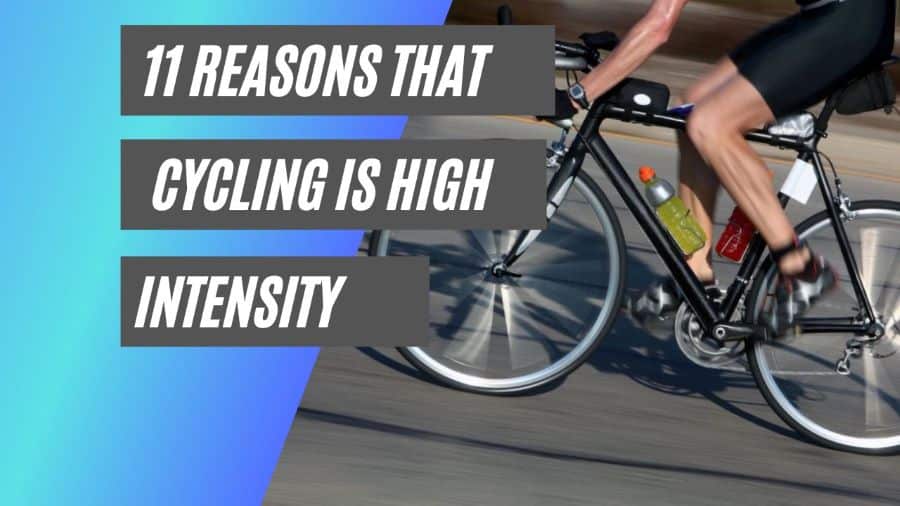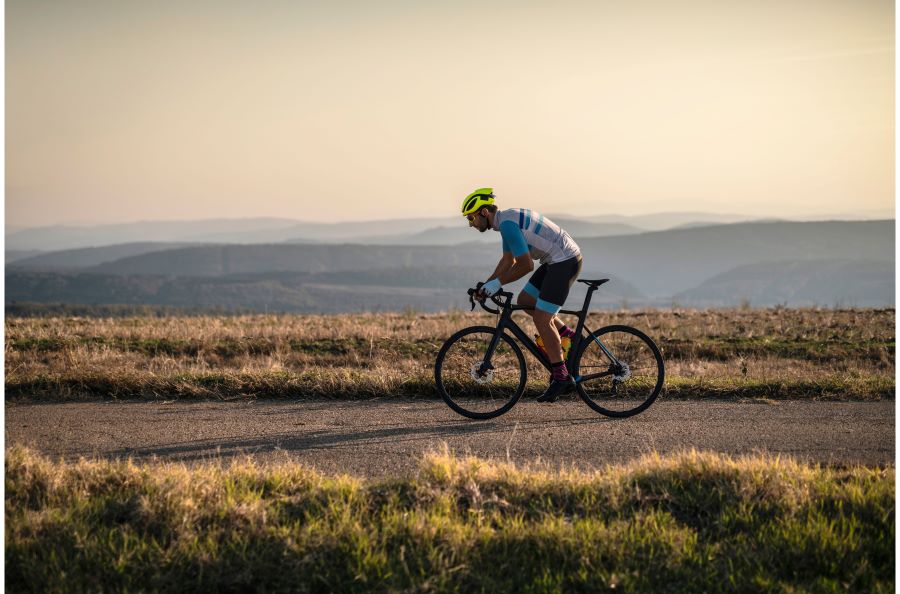This post may contain affiliate links. If you click an affiliate link and make a purchase, I may earn a commission. Also, as an Amazon Associate, I earn from qualifying purchases.--
Fun fact – exercising at the right intensity can do wonders for your health and fitness. To get the most out of your time, experts recommend moderate to high-intensity workouts.
I know that in the past I’ve got the most out of cycling when I’ve really gone for it, and stretched myself to the max!
With that in mind, if you’re planning on upping your exercise routine, you should consider trying high-intensity cycling.
But what is high-intensity cycling? How can you make your cycling sessions high-intensity? And what’s the point?
In this post, I’m going to answer all of these questions, and give you the most important 11 reasons why cycling is high-intensity.

What Is High-Intensity Exercise?
High-intensity interval training (HIIT) is a technique that highlights the importance of time in any workout routine. Experts consider this method the most time-efficient form of exercise. (Source)
HIIT consists of short bursts of intense cardio exercise followed by short recovery periods. You can do this in any type of workout that involves the whole body, like running and cycling (of course!).
The duration of HIIT workouts can be 10 to 30 minutes, depending on your preference. Albeit short, its effects are more effective than regular exercise routines.
What Is High-Intensity Cycling?
If you’re always short on time, this cycling method allows you to benefit from hours of pedaling within minutes. You can do it on both indoor and outdoor bicycles.
The idea is to cram as much physical effort in every interval as possible. Then, allow yourself a few minutes of rest before cranking up the pedal again.
Most HIIT cyclists use the 30 to 60 protocol. This routine means that your cycling should be 30 seconds of fast pedaling, then cooling down for 60 seconds—making up a single interval.
High-intensity cycling has been shown to boost cardiovascular performance, burn fat and calories, and help prevent heart and lung diseases.
Here’s a table of the target areas of intense cycling:
| Target Areas of HIIT Cycling | Impact Of HIIT |
| Strength | Medium |
| Flexibility | Low |
| Endurance | High |
| Balance | Medium |
| Cardio | High |
| Muscle Development | Medium-High |
Let’s take a look at the 11 reasons why cycling is high-intensity:
11 Reasons Cycling Is High-Intensity
The best thing about biking is you can freely control the intensity of your workout. You can pedal at a slower pace or rack up that sweat with intense HIIT cycling.
Cycling is as extreme as many other forms of total body workouts. Its benefits can be as extensive as heavy workouts like body-weight training because you’re using many parts of your body.
Here are 11 reasons cycling can be as effective as a high-intensity form of exercise:
1. Heart
The heart rate is the first marker of intense training. In fact, it’s one of the most objective ways to monitor the degree of exertion your body experiences.
The Live Healthy website states that ‘A 30-year-old cyclist has a maximum heart rate of 190 beats per minute, and thus an average heart rate between 95 and 133 beats per minute when cycling at a moderate pace. At a vigorous pace, the same person’s heart rate is between 133 and 162 beats per minute.’ (Source)
That vigorous pace is what you’re aiming at with high-intensity cycling!
High-intensity cycling stimulates and improves the heart’s muscles. The healthier your heart, the more it can effectively pump blood throughout your body.
Most importantly, a few hours of pedaling a day can reduce the fat in your heart’s blood vessels. For this reason, it lowers your risk of high blood pressure.
So, crank up that bike and work up your heartbeat!
2. Breathing
As cycling is an aerobic activity, it does many good things for your lungs and breathing.
High-intensity exercise can increase the capacity of your lungs, which results in higher endurance.
You can easily sweat while kicking down that pedal too! Plus, the higher the rate of your perspiration, the higher the amount of oxygen your lungs can distribute.
The key to maximizing your breathing while cycling is to use your lungs’ full potential. So, breathe deeply and put your weight on that pedal!
If you’re wondering what the best technique for breathing is when cycling, then I found the following excellent (and short) video from Livestrong on exactly how to do it:
3. Core
One of the best things about biking is it tones muscles, such as your core. Your core is made up of your abs, obliques, and erectors.
The core is responsible for holding and supporting your spine. Thus, strengthening this area of your body positively affects your balance and stature.
All three parts of your core are active during high-intensity cycling. Your abs, pelvis, and lower back work together for efficient and powerful pedaling.
4. Legs
High-intensity cycling is perhaps the most effective cardio exercise for working out your leg muscles. It enhances your lower body without overstressing your joints.
The hamstrings and quadriceps are the most targeted regions of your legs during biking. They are crucial in big-movement activities such as running, walking, and squatting.
If you want to strengthen your legs and improve your cycling, add a combination of leg workouts like squats, lunges, and leg presses. Do it a few times a week, and you’re good to go!
5. Arms
As much as the legs, cycling also enhances your arms’ muscles. Your biceps, triceps, and deltoids are all working when biking.
When high-intensity riding, the upper portion of your body works hard to help you stay on the bike. When you lean, stand, duck, or turn, your arms are the ones that receive the weight.
This constant stress helps tone the muscles in your arms up to your shoulders. With that in mind, don’t be surprised if you notice your upper body getting more buffed.
6. Glutes
Many cyclist will feel a burn in both their quads and glutes when cycling at full intensity – and it’s no surprise!
Pedaling rapidly or against high resistance can enhance the form of your glute muscles when biking. You can locate your glute at the back of your hips.
The glute is responsible for keeping your body upright and for forward movements. A toned and healthy gluteal muscle can significantly improve your balance and support your lower back.
When your glute is weak, you might experience strain on your hips, down to your knees and ankles. So keep pedaling and work that butt off!
7. Calories
If you want to burn calories and fat quickly, then HITT cycling is your best option. A Study that can be found on the National Libary of Medicine website revealed that extreme cycling burns body fat faster than other workout patterns. (Source)
They found that intense cycling in short bursts burns 20% to 30% more calories than traditional exercises. The study’s participants achieved this rate by working only one-third of the time.
Imagine losing calories and body fat within a few minutes of pedaling! Do it regularly, and you should lose that excess weight in no time.
8. Balance
Your balance is one of the things that improve when doing any type of biking.
Ramp it up to high-intensity cycling, and this really beefs this up!
You’re enhancing your abdominal, gluteus, and leg muscles’ stability as you constantly shift your weight on that pedal.
In fact, a study published in 2014 revealed that cycling improves walking gait and balance. After the study, participants have shown greater control over their bodies while walking and running.
It shows that biking can be as effective in improving body movements as other intense training like swimming or running.
9. Coordination
When cycling at high-intensity outdoors, you constantly move several body parts simultaneously. You use your arms to steer, your legs to pedal, and your eyes to watch the way.
With that in mind, regular cycling should improve body-to-eye, arm-to-leg, and hand-eye coordination as you go through constant repetitive movements.
Coordination and balance tend to decline as we get older or during long periods of inactivity. So stay on top and try biking!

10. Stamina
High-intensity cycling is an extremely effective way of boosting your stamina and endurance.
It’s efficient in increasing your cardiovascular stamina as you can work out for extended periods without muscle fatigue.
That said, biking at either low or high speed can help build up your body’s ability to work for prolonged periods of time. You can achieve great results without straining your body too!
For the best outcome, try to stick to a cycling schedule. Gradually increase your mileage per day to improve your endurance.
11. Metabolism
If your goal is to lose weight, HIIT biking can increase your metabolism even more than jogging or weight training. This means you’re still burning calories even after exercising.
In fact, several studies proved that high-intensity interval training, like HIIT biking, increases your body’s metabolic rate for hours after the workout!
What’s more, due to the intensity of the training, the routine pushes your body to convert body fat into energy. This results in quicker weight loss in a relatively shorter time.
How to Start High-Intensity Cycling
There are three primary steps to high-intensity interval biking for both indoors and outdoors: warm-up, pedaling, and resting intervals.
Follow these steps to kickstart your HIIT cycling:
- First, warm up your body by pedaling lightly for 3-4 minutes.
- After warming up, pedal as hard as you can for 30 seconds—be sure that your posture and balance are consistent.
- Once your 30 seconds are up, recover by pedaling slower and lighter for the next 60 seconds.
- Repeat this process about 8 to 10 times until you feel your body heat up.
- Finally, finish your workout with several minutes of light cycling before resting.
Experts recommend doing HIIT cycling two to three times a week. Doing it more than advised would only result in overtraining, which is harmful to your health in the long run.
Here’s a fantastic Youtube video I found from the Global Cycling Network that demonstrates how to do HIIT cycling, and how often:
Final Thoughts
Exercises that involve high-intensity intervals are an excellent way to maximize your time and achieve great results. Fortunately, you can apply the HIIT routine using your bike.
It turns out that pedaling is as extensive as other extreme workouts. It can improve your upper and lower muscles, cardiovascular organs, and overall physical performance.
